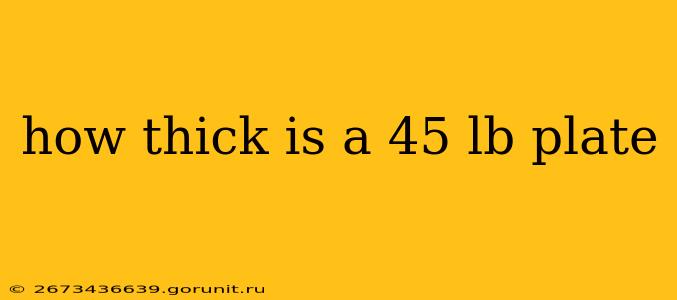How Thick is a 45 lb Weight Plate? A Comprehensive Guide
Determining the exact thickness of a 45 lb weight plate isn't straightforward. The thickness can vary slightly depending on the manufacturer, the specific type of plate (steel, cast iron, bumper), and even minor manufacturing variations. However, we can provide a general range and explain the factors influencing thickness.
Standard Weight Plate Thicknesses
While there's no single universally enforced standard, most commercially produced 45 lb weight plates fall within a specific thickness range. You'll generally find them to be between 1.25 inches (3.175 cm) and 1.5 inches (3.81 cm) thick.
Factors Affecting Plate Thickness:
- Material: Steel plates tend to be thinner than cast iron plates to achieve the same weight. Bumper plates, designed for dropping, often have a slightly thicker design for durability.
- Manufacturer: Slight variations exist between manufacturers. One brand might prioritize slightly thicker plates for added durability, while another might focus on a thinner profile for easier handling.
- Plate Type (Iron vs. Steel vs. Bumper): Cast iron plates might be thicker due to the inherent density of the material, whereas steel plates can achieve the same weight with a reduced thickness. Bumper plates designed for Olympic weightlifting need thicker construction to withstand repeated impacts.
Why Thickness Matters
The thickness of a 45 lb plate isn't just an arbitrary measurement. Several factors depend on it:
- Durability: Thicker plates are generally more durable and resistant to damage from dropping or regular use.
- Stability: Thicker plates provide greater stability on barbells and weightlifting equipment.
- Safety: Thicker plates are less prone to bending or warping, reducing the risk of injury.
- Storage: The thickness affects how many plates you can store efficiently in a given space.
How to Determine the Thickness of YOUR Plates
The best way to know the exact thickness of your 45 lb weight plates is to measure them yourself using a reliable measuring tool such as a caliper or a ruler.
Conclusion
While the thickness of a 45 lb weight plate isn't a rigidly defined standard, understanding the typical range and influencing factors can help you choose plates appropriate for your needs and training style. Remember that measuring your own plates offers the most accurate information.

